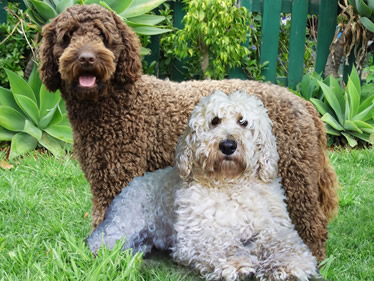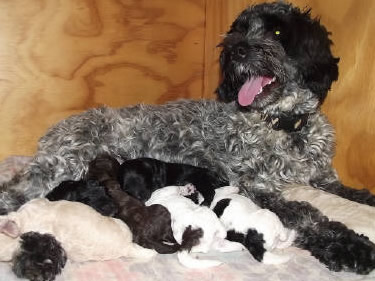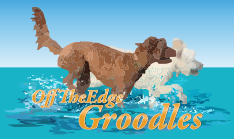Labradoodle Care
Grooming

Handle your Puppy from Day One.
This makes grooming and vet visits much happier for puppy and easier for all involved. Have everyone do it at some point, in a safe and gentle non-threatening manner. Do it sitting up, laying down, on back, etc. and touch/handle all parts of the body. For grooming we use the Hold/Release Method. We hold the puppy in arms where it cannot move or get away, with your hand in its collar. When the puppy struggles we hold very tight, when puppy settles, we loosen hold. Practice 3 times in a row, then move on to something else but repeat regularly.
Guide

The important thing to do is to get puppy used to being combed right from the start, We use a metal comb for both wool coats and fleece coats, and 2 pairs of sharp scissors (larger ones for scissoring the coat and smaller hairdresser ones for doing between the eyes and in the ear canal); which are the only tools you will really need. Trim very short along the ear leather and under the ear flaps, to allow air to circulate in the ears, and under elbows and behind the hind legs.
This trimming can be done once a month. Fleece coats may require more grooming during the transition from puppy to adult coat (5-11 months of age) or scissor your dogs coat to about 40mm. Keep hair trimmed below the eye area, between the eye area to 25mm below the eyes, but never above or below or any wider than this area or you doodle will look silly!
Every day pick out the 2-3 bits of debris in your dog’s coat, which are the major contributors to mats. If you do this you will only need to comb your dog every 2/3 weeks, if not you will need to comb weekly. Use the scissors or a de-matter to cut vertically through the mats and pull the mats open and keep cutting through till gone, especially around the mouth area.
We would recommend scissoring or clipping your dogs coats, but not clipping close to the skin is like shaving your legs, it encourage growth which makes the coat thicker, coarser and curlier. Even wool coats stay softer with scissoring rather than clipping.
Trim the coat a little shorter under the chin, under ear flaps, along the line of the ears, where skin ends on ears (for nice short pert ears), around the collar, throat, under elbows and under/between hind legs, around the bottoms of feet and in between the toes.
The worst mats often form behind the ears, in the tail, legs and around the mouth. After combing, it is important to restore the waves/curls by spraying with an atomizer water bottle, until the outside hair is wet. Pat hands over the dog to flatten and settle coat. Grooming too frequently can make coat overly fluffy and frizzy.
Horror! The Bath!
Labradoodles don’t need a bath as often as most other dogs, but it does depend on the environment they live in. Their coats tend to be nonporous and more resistant to dirt.Fleece coats may require more grooming during the transition from puppy to adult coat (5-11 months of age) or scissor your dogs coat to about 40mm. Keep hair trimmed below the eye area, between the eye area to 25mm below the eyes, but never above or below or any wider than this area or you doodle will look silly!
We find that after a walk during the rainy season they often come back home wet and grubby, and that most of that drops off in a few hours.
When you do bathe it use a good dog shampoo as they have different PH than humans and a conditioner or detangler to keep the coat silky and tangle-free, which makes it easier on them and you. We use an Emu oil dog shampoo and it keeps their coat soft and smelling nice.
Nail Trimming
Buy quality nail clippers from the pet store and start young. Some vets also provide this service.
Weekly Ear Cleaning
Once again most long eared dogs do not get very much air circulation under their ears which can cause ear problems, and a horrible smell to boot. If your dog swims a lot or seems prone to ear infections, use a vet product or see your Vet, as it can develop into ear infections and even hearing loss. So please dry them after swimming or a bath. Clean ears weekly with an ear cleaning solution from your vet, using cotton balls to wipe inner and outer ear. There are a few types on the market. You should also pull the wool from their ears. Ear Powder can help with grip, ask your vets to show you howRed warm ears and strong smell are signs of ear infection. Keep hair trimmed under ear flap (so as to not be noticeable) for ventilation.
Prevention is much better than cure and it is kinder to your dog!
(The use of a Vet product for the ears mentioned above is recommend by the ALA, we use a simpler more effective method, if you wish to know what it is, please ask us)









